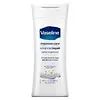CeraVe Intensive Moisturizing Lotion Versus Vaseline Intensive Care Advanced Repair Fragranced Moisturising Body Lotion
What's inside
What's inside
 Key Ingredients
Key Ingredients

 Benefits
Benefits

 Concerns
Concerns

 Ingredients Side-by-side
Ingredients Side-by-side

Water
Skin ConditioningGlycerin
HumectantButyrospermum Parkii Butter
Skin ConditioningHydroxyethyl Urea
HumectantIsopropyl Palmitate
EmollientPropanediol
SolventCetearyl Alcohol
EmollientOctyldodecanol
EmollientC15-19 Alkane
SolventGlycine
BufferingStearic Acid
CleansingCeramide NP
Skin ConditioningCeramide AP
Skin ConditioningCeramide EOP
Skin ConditioningSorbitan Tristearate
EmulsifyingSorbitan Oleate
EmulsifyingCarbomer
Emulsion StabilisingGlyceryl Stearate
EmollientDimethicone
EmollientBehentrimonium Methosulfate
Triethyl Citrate
MaskingIsohexadecane
EmollientSodium PCA
HumectantSerine
MaskingSodium Lauroyl Lactylate
EmulsifyingSodium Hydroxide
BufferingMyristic Acid
CleansingSodium Hyaluronate
HumectantCholesterol
EmollientPalmitic Acid
EmollientAlanine
MaskingTocopherol
AntioxidantHydroxyacetophenone
AntioxidantCaprylyl Glycol
EmollientHydroxyethylpiperazine Ethane Sulfonic Acid
BufferingTrisodium Ethylenediamine Disuccinate
Xanthan Gum
EmulsifyingPentaerythrityl Tetra-Di-T-Butyl Hydroxyhydrocinnamate
AntioxidantPhytosphingosine
Skin ConditioningAcrylamide/Sodium Acryloyldimethyltaurate Copolymer
Emulsion StabilisingAcrylates/C10-30 Alkyl Acrylate Crosspolymer
Emulsion StabilisingPolysorbate 80
EmulsifyingBenzoic Acid
MaskingPEG-100 Stearate
PEG-20 Methyl Glucose Sesquistearate
EmulsifyingWater, Glycerin, Butyrospermum Parkii Butter, Hydroxyethyl Urea, Isopropyl Palmitate, Propanediol, Cetearyl Alcohol, Octyldodecanol, C15-19 Alkane, Glycine, Stearic Acid, Ceramide NP, Ceramide AP, Ceramide EOP, Sorbitan Tristearate, Sorbitan Oleate, Carbomer, Glyceryl Stearate, Dimethicone, Behentrimonium Methosulfate, Triethyl Citrate, Isohexadecane, Sodium PCA, Serine, Sodium Lauroyl Lactylate, Sodium Hydroxide, Myristic Acid, Sodium Hyaluronate, Cholesterol, Palmitic Acid, Alanine, Tocopherol, Hydroxyacetophenone, Caprylyl Glycol, Hydroxyethylpiperazine Ethane Sulfonic Acid, Trisodium Ethylenediamine Disuccinate, Xanthan Gum, Pentaerythrityl Tetra-Di-T-Butyl Hydroxyhydrocinnamate, Phytosphingosine, Acrylamide/Sodium Acryloyldimethyltaurate Copolymer, Acrylates/C10-30 Alkyl Acrylate Crosspolymer, Polysorbate 80, Benzoic Acid, PEG-100 Stearate, PEG-20 Methyl Glucose Sesquistearate
Water
Skin ConditioningGlycerin
HumectantPetrolatum
EmollientCarbon
Stearic Acid
CleansingGlycol Stearate
EmollientTriethanolamine
BufferingDimethicone
EmollientParfum
MaskingTocopheryl Acetate
AntioxidantIsopropyl Isostearate
EmollientTapioca Starch
Cetyl Alcohol
EmollientGlyceryl Stearate
EmollientMagnesium Aluminum Silicate
AbsorbentMethylparaben
PreservativePhenoxyethanol
PreservativePropylparaben
PreservativeDisodium EDTA
Titanium Dioxide
Cosmetic ColorantBenzyl Alcohol
PerfumingButylphenyl Methylpropional
PerfumingCitronellol
PerfumingLimonene
PerfumingLinalool
PerfumingWater, Glycerin, Petrolatum, Carbon, Stearic Acid, Glycol Stearate, Triethanolamine, Dimethicone, Parfum, Tocopheryl Acetate, Isopropyl Isostearate, Tapioca Starch, Cetyl Alcohol, Glyceryl Stearate, Magnesium Aluminum Silicate, Methylparaben, Phenoxyethanol, Propylparaben, Disodium EDTA, Titanium Dioxide, Benzyl Alcohol, Butylphenyl Methylpropional, Citronellol, Limonene, Linalool
 Reviews
Reviews

Ingredients Explained
These ingredients are found in both products.
Ingredients higher up in an ingredient list are typically present in a larger amount.
Dimethicone is a type of synthetic silicone created from natural materials such as quartz.
What it does:
Dimethicone comes in different viscosities:
Depending on the viscosity, dimethicone has different properties.
Ingredients lists don't always show which type is used, so we recommend reaching out to the brand if you have questions about the viscosity.
This ingredient is unlikely to cause irritation because it does not get absorbed into skin. However, people with silicone allergies should be careful about using this ingredient.
Note: Dimethicone may contribute to pilling. This is because it is not oil or water soluble, so pilling may occur when layered with products. When mixed with heavy oils in a formula, the outcome is also quite greasy.
Learn more about DimethiconeGlycerin is already naturally found in your skin. It helps moisturize and protect your skin.
A study from 2016 found glycerin to be more effective as a humectant than AHAs and hyaluronic acid.
As a humectant, it helps the skin stay hydrated by pulling moisture to your skin. The low molecular weight of glycerin allows it to pull moisture into the deeper layers of your skin.
Hydrated skin improves your skin barrier; Your skin barrier helps protect against irritants and bacteria.
Glycerin has also been found to have antimicrobial and antiviral properties. Due to these properties, glycerin is often used in wound and burn treatments.
In cosmetics, glycerin is usually derived from plants such as soybean or palm. However, it can also be sourced from animals, such as tallow or animal fat.
This ingredient is organic, colorless, odorless, and non-toxic.
Glycerin is the name for this ingredient in American English. British English uses Glycerol/Glycerine.
Learn more about GlycerinGlyceryl Stearate is a mix of glycerin and stearic acid.
It is used to stabilize the mixing of water and oil ingredients. By preventing these ingredients from separating, it can help elongate shelf life. It can also help thicken the product's texture.
As an emollient, it helps soften skin and supports barrier-replenishing ingredients.
In cosmetics, Glyceryl Stearate is often made from vegetable oils or synthetically produced.
This ingredient may not be fungal-acne safe
Fun fact: The human body also creates Glyceryl Stearate naturally.
Learn more about Glyceryl StearateStearic Acid is a fatty acid. It is an emollient, emulsifier, and texture enhancer.
As an emollient, stearic acid helps soften skin. It aids the skin's protective barrier by preventing water loss. It also provides a gentle cleansing effect without stripping away natural oils.
Stearic acid may also be used to enhance the texture of products. It can add volume and stabilize ingredients such as water and oil. This can help water and oil ingredients from separating.
Sources of stearic acid include animal or vegetable fats/oils such as coconut or shea. It can be naturally found in butter, cocoa butter, shea butter, vegetable fats, and animal tallow.
This ingredient may not be Malassezia folliculitis, or fungal-acne safe.
Learn more about Stearic AcidWater. It's the most common cosmetic ingredient of all. You'll usually see it at the top of ingredient lists, meaning that it makes up the largest part of the product.
So why is it so popular? Water most often acts as a solvent - this means that it helps dissolve other ingredients into the formulation.
You'll also recognize water as that liquid we all need to stay alive. If you see this, drink a glass of water. Stay hydrated!
Learn more about Water